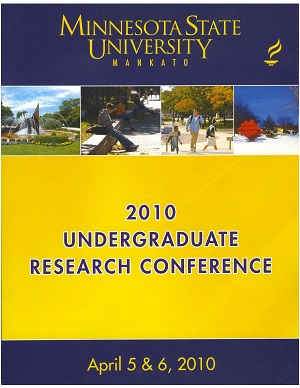Methods of Detecting Injury in Bacillus Cereus
Location
CSU 284A
Start Date
5-4-2010 1:00 PM
End Date
5-4-2010 3:00 PM
Student's Major
Biological Sciences
Student's College
Science, Engineering and Technology
Mentor's Name
Dorothy Wrigley
Mentor's Department
Biological Sciences
Mentor's College
Science, Engineering and Technology
Description
Bacillus cereus is a gram-positive, spore forming bacteria that survives in food and causes food poisoning in humans. Injured cells are more readily killed than uninjured cells. Knowing how to injure Bacillus cereus may provide ways to eliminate its growth in foods. Injury is typically detected when cells die in stressful conditions. The project developed media to detect injured cells. First, Bacillus cereus was frozen at two different temperatures -200C and -800C to check for survival. The survival of the cells was measured by counting viable colony forming units before and after freezing. More cells were killed at -200C than at -800C. A selective medium is needed to determine if surviving cells were injured. A selective media was prepared with polymixin B to which Bacillus cereus is usually resistant. It is hypothesized that freezing damage to cell walls would increase the sensitivity to polymixin B, a membrane disruptor. Polymixin B (antibiotic) mixed with Bacillus cereus yielded an unexpected result. The tested concentration of polymixin B killed Bacillus cereus. Lower concentration of polymixin B are being tested, results will be presented. Sub lethal concentration of polymixin B should not kill uninjured cells, but may kill injured cells. Development of this as a selective medium will allow testing of other potential sources of injury.
Methods of Detecting Injury in Bacillus Cereus
CSU 284A
Bacillus cereus is a gram-positive, spore forming bacteria that survives in food and causes food poisoning in humans. Injured cells are more readily killed than uninjured cells. Knowing how to injure Bacillus cereus may provide ways to eliminate its growth in foods. Injury is typically detected when cells die in stressful conditions. The project developed media to detect injured cells. First, Bacillus cereus was frozen at two different temperatures -200C and -800C to check for survival. The survival of the cells was measured by counting viable colony forming units before and after freezing. More cells were killed at -200C than at -800C. A selective medium is needed to determine if surviving cells were injured. A selective media was prepared with polymixin B to which Bacillus cereus is usually resistant. It is hypothesized that freezing damage to cell walls would increase the sensitivity to polymixin B, a membrane disruptor. Polymixin B (antibiotic) mixed with Bacillus cereus yielded an unexpected result. The tested concentration of polymixin B killed Bacillus cereus. Lower concentration of polymixin B are being tested, results will be presented. Sub lethal concentration of polymixin B should not kill uninjured cells, but may kill injured cells. Development of this as a selective medium will allow testing of other potential sources of injury.
Recommended Citation
Ngum, Adeline. "Methods of Detecting Injury in Bacillus Cereus." Undergraduate Research Symposium, Mankato, MN, April 5, 2010.
https://cornerstone.lib.mnsu.edu/urs/2010/oral-session-06/5



